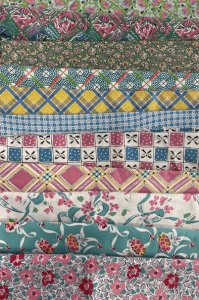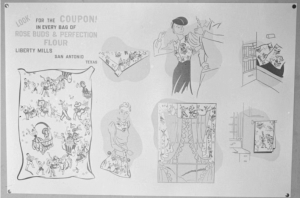
Feedsacks have an interesting history, from utilitarian to fashionable use. Farm and food products were originally shipped and stored in wooden barrels and boxes or tin containers, but in the 1840s feedsacks were introduced to replace these storage methods which were difficult to transport, heavy, leaked or rusted. Feedsacks were durable and reusable, as well as inexpensive.
In the beginning they were plain white and the company or farmer could stamp their brand on the cloth. The price of cotton dropped more between 1914 and 1929 when rayon became popular, and more companies adopted the feedsacks for their packaging. Once companies caught on that women were being savvy and utilizing the sacks for their sewing, they began offering them in colors in 1925, and then colorful prints. Manufacturers printed their labels on paper so they could be removed. By the late 30s, companies began competing with each other to have the best prints to market their goods, hiring artists to design them. Some feedsacks featured border prints to be used for pillow cases, while others had sweet florals or scenic prints. Companies began offering free patterns for dolls, stuffed animals and quilt blocks as well.
When a farmer had more feedsacks than they could use, they could resell the sacks to the store where they would reuse them.
One sack could make a child’s dress or shirt, and three sacks could make a woman’s dress.

Chart inspiring reuse of the feedsack fabric, 1939, Library of Congress
Eventually sewing pattern companies began producing patterns for feedsacks, going as far as providing directions for using the strings of feedsacks in knitting and crocheting—a clever and sustainable method of reusing the full sack during the Depression and Second World War. In 1942 it was estimated that three million women and children of all income levels were wearing feedsack garments.
Written by Ian Drummond
